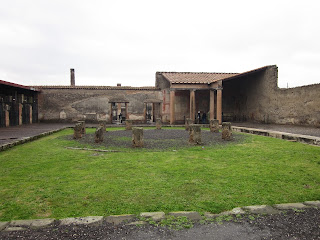 |
| Menander |
 |
| Atrium near tabulium |
Another of the delights of Pompeii.
This house has been a bit reconstructed, however the quality of the surviving paintings is extraordinary.
The name comes from a painting of a writer found on one of the walls, most often identified as Menander. Delightful house, a bit of plumbing work and clearing up some of the damp and I’d be happy to move in. Over 100 pieces of silver dinnerware were found here during excavations, though I think it’s all back in Naples right now.
 |
| House of Menander, Atrium |
Menander was a Greek playwright possibly best known to the modern reader for the comedic play Dyskolos, which I believe is the only one of his works to survive in a near enough complete state as to make translation possible. You can actually read a translation
here. Personally I like The Frogs much better. Plutarch also mentions that the phrase “Alea iacta est”, most famously quoted “Terminator style” by Julius Caesar as he was crossing the Rubicon, came from one of Menander’s plays. Caesar always gets the best catchphrases, one has to wonder if he had a writer
come up with a steady stream of them? Otherwise I’m ure we would end up with such-phrases as “Veni, vidi, vomo” (I came, I saw, I barfed), phrases that silly little school boys come up with in Latin class and laugh about non-stop. I should know, I certainly did.
 |
| Peristyle and garden |
The atrium is well preserved and the temple to the Lares (or household gods) made me squeal with delight. Which, I have been told was pretty comical in a grown man with a handlebar mustache.
The impluvium is well preserved as are the columns flanking the tablinium that leads to the peristyle and garden. The latter has been recreated with an eye towards historical accuracy, as far as I have
 |
| Household shrine and stairs |
been told! looks like boxwood to me, but I tend to have a black thumb when it comes to plants so I try not to get too close. Having the roof restored makes this a really nice spot to get out of the rain or the sun, depending on the time of year one is visiting.
Other houses in Pompeii, such as the House of the Faun, or the House of Pansa, might be significantly larger, but they are quite obviously ruins. The House of Menander is presented in such an incredible state of preservation and restoration that life in the first century AD becomes quite imaginable. And, I suppose, livable; as long as you were the one that owned the house and not the one that had to empty the slop buckets. Which is still gross, and one of the reasons I hate camping, now where did that rant come from?
 |
| Peristyle and garden with roof over atrium |





























